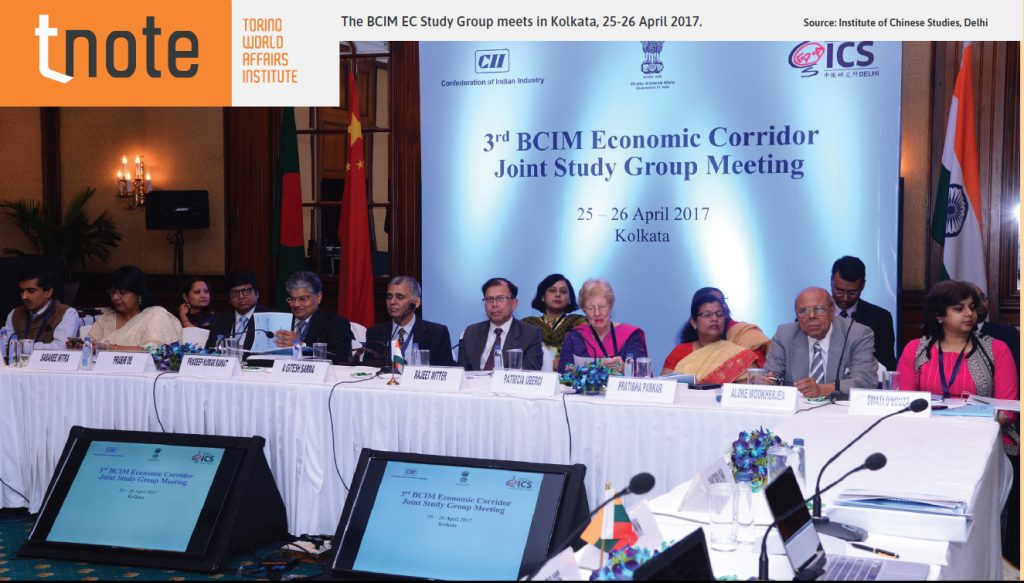
The regionalization trend that Asia has experienced over the past two decades has led to the formulation of numerous initiatives. These, however, often lack a clear implementation strategy. The example here examined is that of the Bangladesh-China-India-Myanmar Economic Corridor (BCIM EC). In 2013, when India and China bilaterally agreed to establish this corridor, Bangladesh and Myanmar soon joined. In a joint statement with the Chinese government during her visit to China in August 2016, Aung San Suu Kyi supported the aims of BCIM EC in her function as State Counsellor. The main objectives of the BCIM EC project are the development of regional transport infrastructure, the accelerated exploitation of the resource-rich region, the expansion of regional trade and border crossings, and the establishment of industrial growth zones.
Myanmar government representatives, the provincial government of Yunnan and think tanks from India and Bangladesh have been calling for closer regional economic cooperation since 1999, and so have the central governments of their respective countries 14 years later. The notion allowed actors involved to establish strong professional and personal ties, but still lacks a clear action plan. A Joint Study Group established by the four governments received the mandate to work up to 2018 on the formulation of such plan, and on other various projects to be realised under the BCIM EC framework. While the BCIM EC prioritises the joint fostering of trade and infrastructure at its core, regional development is currently unregulated. This not only has the potential to worsen old conflicts, but it could even lead to the outbreak of new ones.
Two pipelines for crude oil and gas connect the Golf of Bengal with Southwest China, for instance. The Myanmar section of the two pipelines runs for nearly 800 km. The first gas extracted from the Shwe gas fields at the Golf of Bengal reached China in 2013, and Middle Eastern crude reached China (without having to pass through the Malacca Strait) for the first time this year. It is planned that between 5 to 10% of the total crude oil imports of China will be delivered through these pipelines. Myanmar will consume around 10% of the gas it extracts, while all crude oil will be transported to China.
Energy supply routes alternative to the sensitive Malacca Strait are often taken as evidence that China is capable of achieving its strategic goals more effectively than India. Chinese analysts, however, have highlighted the scope of security risks associated with the pipelines. On-going violent conflicts in Southern Kachin State and Northern Shan State – through which the pipelines run – lead to concerns that the pipelines’ operation could be significantly disturbed. Local militias could even threaten to disrupt energy supplies to blackmail the governments of either Myanmar or China.
As an example of this, clashes between the Myanmar army and three armed ethnic groups took place last November, severely affecting the Burmese township of Muse. Trade in Muse ceased, causing several thousand civilians to flee to Yunnan. This is indicative of the fact that ethnic armed groups could exert economic pressures on China and Myanmar by disrupting pipeline operations with the intent of shaping policies that affect either them or the entire region.
The 3.6 billion USD hydroelectric project of the Myitsone Dam in Kachin State, however, has proved far more controversial. In 2009, China Power Investment Corporation and the Myanmar Ministry of Electric Power signed a construction contract according to which 90% of produced electricity had to be exported to China. After 50 years, ownership of the hydroelectric power plant would be fully transferred to the government of Myanmar. Construction works started at the end of 2009, but the planned resettlement of more than 10,000 people and reports concerning potential damages of cultural sites and downstream agriculture quickly led to protests. In 2010, the Kachin Independent Army (KIA) started perpetrating attacks against the construction site, and tension escalated in heavy fights, thus ending a 17-years long ceasefire between the KIA and the Burmese army. Around 20,000 people fled to Yunnan. In September 2011, one month after Aung San Suu Kyi had proposed the halting of the dam, former president Thein Sein formally announced it. Since then, no decision on either continuing or suspending the project has been taken. Observers see this move as Myanmar’s act of “national defence” to reduce China’s ever-growing influence over the country.
The third example is that of the Letpadaung Copper Mine in the Saiging Region, an investment that accounted for 1.1 billion USD, and corresponded to China’s largest mining investment in Myanmar. Chinese Premier Wen Jiabao signed the first version of the contract in 2010. Construction work at the Letpadaung mine started in the following year, but had to be halted in 2012 due to issues of environmental degradation. A parliamentary commission under Aung San Suu Kyi conducted an investigation on the construction site. Once the commission’s evaluation report was approved, construction work was resumed in March 2013. The mine delivered its first copper in 2016. There are, however, numerous reports that shed lights on toxic waste management on the one hand and police brutality against local environmental initiatives on the other.
These examples show that, with an uneven distribution of benefits, big extractive projects have the potential of highly destabilizing the regions in which they’re carried out. Investments in Myanmar remain dangerous due to conflicts that are yet to be solved. Regional initiatives like the BCIM EC could get governments to agree on joint investment and regional development regulations, thereby having a positive impact on the region. Whether the Joint Study Group of the BCIM EC will be able to formulate and enforce principles of economic interaction that balance different interests and contribute to a more peaceful path of development, however, remains an open question.
Anja Senz is professor of Chinese Politics at Heidelberg University
Download


Copyright © 2025. Torino World Affairs Institute All rights reserved
